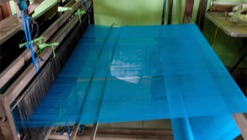Chance conversations during travel (2016) revealed shared interests: open air studio Shinnecock Hills spacetime sited in “Sandrow’s own backyard” inspired talk of backyard sites on the other side of the world. As collaborative offsite components of The Fabric of time and space spacetime. One specific to the endangered Gallus Varius (Indonesian Green Jungle Fowl or Kekur): open air studio Silangjana spacetime planned with Sudipa Yasa Family and Village leader Komang Suparma in Silangjana, Sukasada, Buleleng Regency, Bali Indonesia. Pacific Islanders value Kekur Roosters (who solely live on Indonesian Islands) for their caws, placing them on canoes to help navigate seas by listening to the distant roosters answering theirs. The other, possibility of an underwater coral regeneration art work along coastal shorelines where Kekur live and forage: open air studio Komodo spacetime with Mikel Albaran Valle off shore Sebayur Island, Komodo National Park, West Mangarrai Regency, East Nusa Tenggara Indonesia.
Each of the three sites, one amongst Oak and Pine Woods (Shinnecock Hills), another in a tropical rainforest (Silangjana), the third along coastal shores (Komodo) of mangrove purposefully place Sandrow’s multi disciplinary installations.
At Yayasan Bali Purnati Center for the Arts, Sandrow happened to meet Bali Aga priest and Travel Guide Sudipa Yasa and, together for three days, traveled to find a Kekur Cockeral. Kekurs and the hybrid Bekisar live freely in most every villager’s backyard and at the edge of rainforests, for which common ground was found with Sandrow keeping a flock, her life as an artist. Sandrow gifted the Kekur male (found in a bird shop) as a mate for the family’s Kekur Hen (pictured, together right) to help realize the Sudipa’s dream of a preservation project to save the Kekur genetic lineage. How a variation of Sandrow’s backyard installation for breeding Padovana’s (Shinnecock Hills, since 2006) to be adapted in Silangjana for preserving Kekur (both breeds 160 million years old). That will evolve into a teaching tool and the first public art work of its kind here, maintained enthusiastically by the Sudipa Yasa family: providing new resources and income for them, their neighbors. Where researchers and bird enthusiasts can study and observe Kekurs “uncaged”. Transforming a village of ethnic minority Bali Aga rice workers struggling to survive poverty conditions into a thriving eco destination with support of Village leader Suparma.
Under waters (Komodo National Park, Sea of Flores nearby Mangarrai Todo and Komodo Villages) framed by island coastlines where wild Kekurs forage for food amidst mangrove forests, Sandrow’s installation would take shape with local marine biologists and experts led by Valle. Functioning as both sculpture and coral regeneration beds nearby the Secret Garden. Sun bleached (dying) coral fragments identified and cleaned; then attached to rebar frames that Sandrow would shape, weld in the form of the Weavers Looms and Spinners, Native Kapok (Cotton) Trees. This underwater installation would alternatively present a preview of a flooded landscape from rising seas; soon after the shaped rebar frames would transform into a tapestry of living forms, “coral carpets” resembling songke and songkett. “Coral regeneration or gardening” would nurture sustainable tourism.
Art intertwined with life is a belief and practice shared by Sandrow with Bali Aga and Mangarrai. As another facet of these collaborations, Sandrow might be accompanied by Shinnecock Nation Cultural Consultant, Performance Artist Shane Weeks who makes traditional objects including wampum and regalia, in a first time exchange of histories and practices. The two offsite collaborations would display global as well as personal interconnections, mutual support of conservation and preservation efforts, shared social concerns between two indigenous cultures.
copyright © 2021 Hope Sandrow all rights reserved




